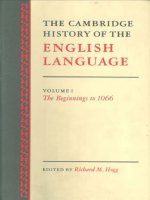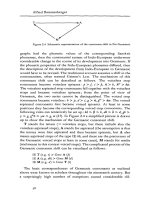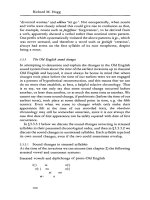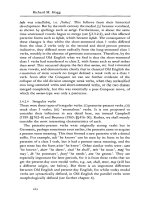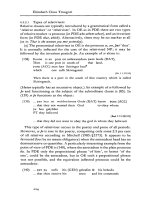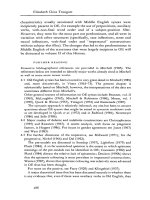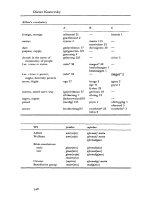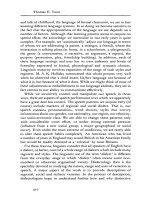The cambridge history of china volume 6 alien regimes and border states, 907—1368
Bạn đang xem bản rút gọn của tài liệu. Xem và tải ngay bản đầy đủ của tài liệu tại đây (45.53 MB, 805 trang )
Tai Lieu Chat Luong
I
THE CAMBRIDGE HISTORY
OF CHINA
General Editors
D E N I S TWITCHETT and J O H N K. FAIRBANK
Volume 6
Alien regimes and border states, 907—1368
Cambridge Histories Online © Cambridge University Press, 2008
Work on this volume was partially supported by the National Endowment for
the Humanities, Grants RO-21512-87 and RO-22077-90.
Cambridge Histories Online © Cambridge University Press, 2008
THE CAMBRIDGE
HISTORY
OF CHINA
Volume 6
Alien regimes and border states, 907—1368
edited by
HERBERT FRANKE and DENIS TWITCHETT
CAMBRIDGE
UNIVERSITY PRESS
Cambridge Histories Online © Cambridge University Press, 2008
CAMBRIDGE UNIVERSITY PRESS
Cambridge, New York, Melbourne, Madrid, Cape Town, Singapore, Sao Paulo
Cambridge University Press
40 West 20th Street, New York, NY 10011-4211, USA
www.cambridge.org
Information on this title:www.cambridge.org/9780521243315
© Cambridge University Press 1994
This publication is in copyright. Subject to statutory exception
and to the provisions of relevant collective licensing agreements,
no reproduction of any part may take place without
the written permission of Cambridge University Press.
First published 1994
Reprinted 2002, 2006
Printed in the United States of America
A catalogue recordfor this book is availablefromthe British Library.
Library of Congress Cataloguing in Publication Data
(Revised for vol. 6)
The Cambridge history of China.
Vol 1. edited by Denis Twitchett and Michael Loewe;
v. 6 edited by Herbert Franke and Denis Twitchett;
v. 7 edited by Frederick W. Mote and Denis Twitchett;
v. 11 edited by John K. Fairbank and Kwang-Ching Liu;
v. 13 edited by John K. Fairbank and Albert Feuerwerker;
v. 14 edited by Roderick MacFarquhar and John K. Fairbank;
v. 15 edited by Roderick MacFarquhar and John K. Fairbank.
Includes bibliographies and indexes.
Contents: v 1. The Ch'in and Han Empires,
221 B.C.—AD. 220 — v. 3. Sui and T'ang China, 589—906, pt. 1 —
—v. 6 Alien regimes and border states, 710—1368.
1. China — History. I. Twitchett, Denis Crispin. II. Fairbank, John King, 1907—1991.
DS735.C3145 951' .03 76—29852
ISBN-13 978-0-521-24331-5 hardback
ISBN-10 0-521-24331-9 hardback
Cambridge University Press has no responsibility for
the persistence or accuracy of URLs for external or
diird-party Internet Web sites referred to in this publication
and does not guarantee that any content on such
Web sites is, or will remain, accurate or appropriate.
Cambridge Histories Online © Cambridge University Press, 2008
GENERAL EDITORS' PREFACE
When The Cambridge History of China was first planned, more than two
decades ago, it was naturally intended that it should begin with the very
earliest periods of Chinese history. However, the production of the series has
taken place over a period of years when our knowledge both of Chinese
prehistory and of much of the first millennium B.C. has been transformed by
the spate of archaeological discoveries that began in the 1920s and has been
gathering increasing momentum since the early 1970s. This flood of new
information has changed our view of early history repeatedly, and there is not
yet any generally accepted synthesis of this new evidence and the traditional
written record. In spite of repeated efforts to plan and produce a volume or
volumes that would summarize the present state of our knowledge of early
China, it has so far proved impossible to do so. It may well be another decade
before it will prove practical to undertake a synthesis of all these new discoveries that is likely to have some enduring value. Reluctantly, therefore, we
begin the coverage of The Cambridge History of China with the establishment
of the first imperial regimes, those of Ch'in and Han. We are conscious that
this leaves a millennium or more of the recorded past to be dealt with
elsewhere, and at another time. We are equally conscious of the fact that the
events and developments of the first millennium B.C. laid the foundations for
the Chinese society and its ideas and institutions that we are about to
describe. The institutions, the literary and artistic culture, the social forms,
and the systems of ideas and beliefs of Ch'in and Han were firmly rooted in
the past and cannot be understood without some knowledge of this earlier
history. As the modern world grows more interconnected, historical understanding of it becomes ever more necessary and the historian's task ever more
complex. Fact and theory affect each other even as sources proliferate and
knowledge increases. Merely to summarize what is known becomes an awesome task, yet a factual basis of knowledge is increasingly essential for
historical thinking.
Since the beginning of the century, the Cambridge histories have set a
pattern in the English-reading world for multivolume series containing
chapters written by specialists under the guidance of volume editors. The
Cambridge Histories Online © Cambridge University Press, 2008
vi
GENERAL EDITORS' PREFACE
Cambridge Modern History, planned by Lord Acton, appeared in sixteen
volumes between 1902 and 1912. It was followed by The Cambridge Ancient
History, The Cambridge Medieval History, The Cambridge History of English
Literature, and Cambridge histories of India, of Poland, and of the British
Empire. The original Modern History has now been replaced by The New
Cambridge Modern History in twelve volumes, and The Cambridge Economic
History of Europe is now being completed. Other Cambridge histories include histories of Islam, Arabic literature, Iran, Judaism, Korea, South East
Asia, Central Asia, Africa, Japan, and Latin America.
In the case of China, Western historians face a special problem. The
history of Chinese civilization is more extensive and complex than that of any
single Western nation, and only slightly less ramified than the history of
European civilization as a whole. The Chinese historical record is immensely
detailed and extensive, and Chinese historical scholarship has been highly
developed and sophisticated for many centuries. Yet until recent decades the
study of China in the West, despite the important pioneer work of European
sinologists, had hardly progressed beyond the translation of some few classical historical texts, and the outline history of the major dynasties and their
institutions.
Recently Western scholars have drawn more fully upon the rich traditions
of historical scholarship in China and also in Japan, and greatly advanced
both our detailed knowledge of past events and institutions, and also our
critical understanding of traditional historiography. In addition, the present
generation of Western historians of China can also draw on the new outlooks
and techniques of modern Western historical scholarship and on recent developments in the social sciences, while continuing to build on the solid foundations of rapidly progressing European, Japanese, and Chinese studies. Recent
historical events, too, have given prominence to new problems, while throwing into question many older conceptions. Under these multiple impacts the
Western revolution in Chinese studies is steadily gathering momentum.
When The Cambridge History of China was first planned in 1966, the aim
was to provide a substantial account of the history of China as a benchmark
for the Western history-reading public: an account of the current state of
knowledge in six volumes. Since then the outpouring of current research, the
application of new methods, and the extension of scholarship into new fields
have further stimulated Chinese historical studies. This growth is indicated
by the fact that the history has now become a planned fifteen volumes but
will still leave out such topics as the history of art and of literature, many
aspects of economics and technology, and all the riches of local history.
The striking advances in our knowledge of China's past over the last
decade will continue and accelerate. Western historians of this great and
Cambridge Histories Online © Cambridge University Press, 2008
GENERAL EDITORS
PREFACE
VII
complex subject are justified in their efforts by the needs of their own peoples
for greater and deeper understanding of China. Chinese history belongs to the
world not only as a right and necessity, but also as a subject of compelling
interest.
JOHN K. FAIRBANK
DENIS TWITCHETT
Cambridge Histories Online © Cambridge University Press, 2008
Cambridge Histories Online © Cambridge University Press, 2008
CONTENTS
General editors' preface
List of maps, tables, and
Preface to Volume 6
List of abbreviations
figures
Introduction
page v
xiv
xvii
xix
i
by H E R B E R T F R A N K E , Universitat Muncben, Emeritus, and
D E N I S T W I T C H E T T , Princeton University, Emeritus
The Late T'ang balance of power
The frontier
Foreigners
Vassals and overlords
Multistate system
Treaty relations
Modes of government
Multilinguality
The Han Chinese under alien domination
i
The Liao
3
7
11
14
16
18
21
30
36
43
by D E N I S T W I T C H E T T and
KLAUS-PETER TIETZE
Introduction
The predynastic Khitan
The background of A-pao-chi's rise to power
The rise of A-pao-chi
A-pao-chi becomes the new khaghan and ascends the
throne
The succession crisis and the reign of T'ai-tsung
The succession of Shih-tsung
The development of government institutions
Relation with regimes in China
The reign of Mu-tsung, 951—969
IX
Cambridge Histories Online © Cambridge University Press, 2008
43
44
53
56
60
68
75
76
80
81
CONTENTS
The reign of Ching-tsung, 969—982: confrontation with Sung
The regency of Empress Dowager Ch'eng-t'ien
Changes in internal government
Foreign relations
The reign of Hsing-tsung
The reign of Tao-tsung
The reign of T'ien-tso and the collapse of the Liao
Final disaster
The Hsi Hsia
by R U T H D U N N E L , Kenyon College
Introduction
The ethnogenesis of the Tangut people
The surrender to T'ang and settlement in the Ordos
The end of the T'ang
The Tanguts during the Wu-tai period
The Tangut move toward independence, 982—1002
Liang-chou and Tangut expansion into Ho-hsi
The rise of the Tibetan Tsung-ko dynasty
Li Te-ming, 1004-1032
Ho-hsi after the Tangut conquest
Li Yiian-hao (Wei-ming Nang-hsiao, Ching-tsung), 10321048
The succession to Wei-ming Yiian-hao
A state in peril: the reigns of I-tsung (1048-1068), Huitsung (1068-1086), and Ch'ung-tsung to 1100
The reign of Hui-tsung (1068-1086)
Hsia comes of age: Ch'ung-tsung (1086—1139) and Jentsung (1140-1193)
The last years of the Hsia state and the Mongolian conquest
The Chin dynasty
by
HERBERT
84
87
91
98
114
123
139
149
154
154
155
158
161
164
168
172
173
176
179
180
189
191
193
197
205
215
FRANKE
General remarks
The Jurchen people and their predynastic history
The reign of A-ku-ta and the founding of the Chin dynasty
From war to coexistence: Chin—Sung relations before the
treaty of 1142
The political history of Chin after 1142
The annihilation of Chin, 1215-1234
Cambridge Histories Online © Cambridge University Press, 2008
215
216
220
226
235
259
CONTENTS
Government structure
Social structure
Ethnic groups
Economic conditions
Scholarship, literature, and the arts
Religious life
Conclusion
4 The rise of the Mongolian empire and Mongolian rule in
north China
by THOMAS A L L S E N , Trenton State College
Mongolia and Temiijin, ca. 1150—1206
Chinggis khan and the early Mongolian state, 1206-1227
The organization of the empire: the reigns of Ogodei and
Giiyiig
The empire at its apogee: the reign of Mongke, 1251-1259
Epilogue: The empire on the eve of civil war
XI
265
277
279
291
304
313
319
321
321
342
365
390
411
5 The reign of Khubilai khan
414
by M O R R I S ROSSABI, City University of New York, Columbia
University
The early years
Khubilai and China, 1253—1259
Khubilai versus Arigh Boke
Foreign expansion
Social and economic policies
Khubilai as emperor of China
Khubilai and religion
Khubilai and Chinese culture
Preservation of the Mongolian heritage
Economic problems in later years
The regime of Sangha and economic and religious abuses
Disastrous foreign expeditions
Khubilai's last years
6 Mid-Yuan politics
by H S I A O C H ' I - C H ' I N G , University of Singapore
Introduction
The reign of Temiir khaghan (Emperor Ch'eng-tsung),
1294-1307
Cambridge Histories Online © Cambridge University Press, 2008
414
418
422
429
445
454
457
465
471
473
478
482
488
490
490
492
Xii
CONTENTS
Temiir's succession
The conservator of Khubilai's achievements
Signs of decline
The transition to peace
The dominance of Empress Bulukhan
The reign of Khaishan (Emperor Wu-tsung), 1307-1311
Administrative anomalies
The "new deals"
The reign of Ayurbarwada khaghan (Emperor Jen-tsung),
494
496
498
501
504
505
507
510
1311—1320
513
The reign of Shidebala khaghan (Emperor Ying-tsung),
1320-1323
The coup d'etat at Nan-p'o
The reign of Yesiin Temiir khaghan (Emperor T'ai-ting),
1323-1328
The reign of Tugh Temur (Emperor Wen-tsung), 13281332
The failure of the succession arrangements
The period in retrospect
7 Shun-ti and the end of Yuan rule in China
•
by J O H N D A R D E S S , University of Kansas
Yuan China at the accession of Toghon Temur (Shun-ti)
ToghSn Temiir's enthronement and Bayan's chancellorship,
1333-134°
Toghto and his opposition, 1340-1355
The disintegration of the Yuan
Conclusion: Why did the Yuan dynasty fall?
8 The Yuan government and society
by E L I Z A B E T H E N D I C O T T - W E S T , Harvard University
Government
Society
9 Chinese society under Mongol rule, 1215-1368
by F R E D E R I C K W. M O T E , Princeton University, Emeritus
The Mongolian period in Chinese history
The population of Yiian China
Social—psychological factors
Social classes: traditional and new elites
Cambridge Histories Online © Cambridge University Press, 2008
527
532
535
541
556
557
561
561
566
572
580
584
587
587
608
616
616
618
622
627
CONTENTS
Confucian households
Diffusion of elite roles
The meaning of the Yiian drama in Yiian period social
history
Cultural diversity
The Western Asians' changing relationship to the Chinese
elite
Social classes: sub-elite and commoner
Other aspects of Yiian dynasty social history
Households in bondage
Xlll
635
638
640
643
644
648
657
661
Bibliographical essays
Bibliography
665
727
Glossary-Index
777
Cambridge Histories Online © Cambridge University Press, 2008
MAPS, TABLES, AND FIGURES
Maps
1
2
3
4
5
6
7
8
9
10
11
12
13
14
15
16
17
18
19
20
21
22
23
24
25
26
The Khitan and north China, A.D. 908
The Khitan and north China, A.D. 924
The Khitan and north China, A.D. 943
The Khitan and north China, A.D. 959
The Liao campaigns against Koryo, 993-1019
The Liao invasion of Sung, 1004
The Liao empire, ca. 1045
The fall of Liao and the Chin invasions, 1017-24
The Hsi Liao (Khara Khitan) empire, 1131 —1213
The growth of the Hsi Hsia state
The Tsung-ko region
The Hsi Hsia state, 1111
The first Mongolian invasion of Hsi Hsia, 1209
Chinggis's invasion of Hsi Hsia, 1226-7
The Chin invasions of Northern Sung
Chin raids south of the Yangtze, 1129-30
The Chin empire
The change of the Huang-ho's course, 1194
Chinggis's campaigns against Chin
The rebellions in Manchuria and Shantung
Mukhali's campaigns against Chin
The destruction of Chin, 1234
Population distribution in Chin, ca. 1211
The steppe world, 1190
The campaigns in Manchuria, 1211 —16
Chinggis's western campaigns
xiv
Cambridge Histories Online © Cambridge University Press, 2008
page 55
65
71
83
101
106
118
145
152
171
174
184
209
2I2
228
231
236
246
253
255
260
262
280
322
353
355
MAPS, TABLES, A N D FIGURES
XV
27
28
29
Batu's invasion of Russia and Europe
The Mongolian invasions of Koryo
The conquest of Ta-li
369
371
406
30
31
The Mongolian khanates
The conquest of Southern Sung
425
432
32
33
34
The Yuan empire
The Yuan capital, Ta-tu
The Yuan grain transport system
438
456
477
35
36
Khubilai's invasions of Japan
Khubilai's invasions of Southeast Asia
483
486
37
Registered population distribution of Yuan China
619
Tables
1 Liao emperors and their regnal titles
2 Hsia emperors and regnal titles
3 Chin emperors and regnal titles
4 Regnal titles of Mongolian rulers
5 Capital cities
6 The Yao-lieh khaghans
7 Total population of Chin
8
Numbers of households registered in Hopei and Shantung
xxii
xxiv
xxvi
xxviii
xxix
51
278
621
Figures
1
2
3
A-pao-chi's descent and the structure of the Yeh-lii clan
Outline genealogy of Liao
Genealogy of the Hsia ruling house
xx
xxi
xxiii
4
5
6
Genealogy of the early Jurchen rulers
Genealogy of the Chin emperors
Genealogy of Mongolian rulers
xxv
xxv
xxvii
Cambridge Histories Online © Cambridge University Press, 2008
Cambridge Histories Online © Cambridge University Press, 2008
PREFACE TO VOLUME 6
Names and terms in Volume 6 ofThe Cambridge History of China are transliterated as follows:
Chinese is romanized according to the Wade-Giles system, which, for all
its imperfections, is employed in most of the serious literature on China
written in English. There are a few exceptions, which are noted below.
Japanese is romanized according to the Hepburn system.
Mongolian is transliterated according to the system found in A. Mostaert,
Dictionnaire ordos, vol. 3, "Index des mots du mongol ecrit et du mongol
ancien" (Peiping, 1944). The only deviations from the Mostaert system are q,
which becomes kh; y, which becomes gh; Z, which becomes ch; /, which
becomes sh; and / , which becomes /'.
Tibetan is transliterated according to the system used in Sarat Chandra
Das, A Tibetan—English Dictionary (Calcutta, 1902).
Persian is transliterated according to the Library of Congress system.
Turkic is transliterated according to the system found in V. M. Nadeliaev
et al., Drevnetiurkskii slovar' (Leningrad, 1969), with the following modifications: y becomes gh; if becomes ch; and / becomes sh.
Chinese and Japanese personal names follow their native form, that is,
with the surname preceding the given name. In the case of Chinese and
Japanese authors of Western-language works, the names are given in the
published form, in which the given name may sometimes precede the surname (e.g., Hok-lam Chan), and the orthography may employ a system
other than Wade-Giles.
Chinese place names are romanized according to the Wade—Giles system,
with the exception of those places familiar in the English-language literature in
nonstandard postal spellings. For a list of these, see G. William Skinner, Modern
Chinese Society: A Critical Bibliography (Stanford: Stanford University Press,
1973), vol. 1, Introduction, p. xii. Modern place names are generally not
hyphenated (e.g., Hopei is the modern province of that name), whereas contemporary place names are hyphenated (Ho-pei, Hsi-lu, the Chin period circuit).
The maps are based on the standard historical atlas of China: T'an Ch'ihsiang, ed., Chung-kuo li-shih ti-t'u chi, 2nd rev. ed. (Shanghai: Chung-hua
xvn
Cambridge Histories Online © Cambridge University Press, 2008
xviii
PREFACE TO VOLUME 6
ti-t'u hsiieh she, 1974—6; Peking: Ti-t'u ch'u-pan she, 1980—1), vol. 6,
covering Sung, Liao, Hsi-Hsia, and Chin, and vol. 7, covering the Yuan
period. Maps 23 and 37 are adapted from the Bulletin of the Museum of Far
Eastern Antiquities, 59 (1987), pp. 214, 215.
The Chinese official titles generally follow Charles O. Hucker's A Dictionary
of Official Titles in Imperial China (Stanford: Stanford University Press, 1985).
However, for our period, this work is incomplete in some respects. The usage
of titles under all the regimes covered in this volume was constantly changing,
and the reader should remember that the same office title was often used by the
Sung, Liao, Hsia, Chin, and Yuan with somewhat different connotations,
sometimes necessitating differing English translations.
Emperors are referred to by their temple names during their reign and by their
personal names before their succession to the throne. Lists of emperors, giving
the various regnal titles used during their reigns, are provided in Tables 1-4.
Dates normally follow the Chinese form rather than the Western calendar.
The reader should be aware that the Chinese year is normally converted to a
corresponding Western year but that these do not correspond exactly. Thus,
for example, the Treaty of Shan-yuan was concluded in the Chinese year
equivalent to 1004, though this was actually 24 January 1005.
ACKNOWLEDGMENTS
The editors of this volume have faced great problems arising from the complexity of the period and its sources, and the variety of languages and cultures that
impinge on its story. We wish to express out gratitude to all those members of
the international scholarly community whose advice we have requested on
points of detail and to thank them for their careful responses. In particular, we
wish to acknowledge the assistance of Professor Frederick W. Mote, who read
and commented in detail on all the contributions to this volume, and the
editorial work of Dr. James Geiss, who devoted a decade of meticulous scholarly attention to this and other volumes of The Cambridge History of China. We
also wish to thank Professor Elizabeth Endicott-West, who not only contributed her own chapter to this volume but also assisted the editors in ensuring
that the usage of Mongolian, Turkic, Tibetan, and Persian terms is uniform
throughout, and Mrs. Soo-won Kim, who advised us on Korean problems.
Preparing this volume took several years, and our work was made possible
by the generous support of the National Endowment for the Humanities and
by Princeton University.
DCT
HF
Cambridge Histories Online © Cambridge University Press, 2008
ABBREVIATIONS
BIHP
CS
CTKC
CTS
HCP
HJAS
HTS
HYS
JAS
KHCPTS
LS
SKCS
SPPY
SPTK
SS
THY
TSCC
YS
YTC
Bulletin of the Institute of History and Philology (Academia Sinica)
(Chung yang yen chiu yiian, Li shih yii yen yen chiu so chi K'an)
Chin shih
Ch'i-tan kuo chih
Chiu Tang shu
Hsu Tzu-chih t'ung-chien ch'ang-pien
HarvardJournal of Asiatic Studies
Hsin Tang shu
K'o Shao-min, Hsin Yuan shih
Journal of Asian Studies
Kuo hsiieh chi pen ts'ung shu
Liao shih
Ssu k'u ch'iian shu chen pen
Ssupupeiyao
Ssu pu ts'ung k'an
Sung shih
Tang hui yao
Ts'ung shu chi ch'eng
Yuan shih
Ta Yiian sheng cheng kuo ch'ao tien chang
xix
Cambridge Histories Online © Cambridge University Press, 2008
Nou-li-ssu* (Su-tsu)
I
I
Chih-shen*
Ti-lu-ku*
I
I
(died young)
Shu-la
Yun-tt-shib* (Hsiian-tsu)
(murdered by T'ieh-la)
Tiieh-la*
/I
(died young)
I
Tu-lu-chiin*
/
Yen-ku-chih* /
(driven from /
office by
/
Hsia-li
Ko-la
Sa-la-U" (l-tsu)
y I
I1
Hsia-ti# y
I S
X
T
A-pao-chi*
r
,-~~
Yen-mu # (three times)
Ma-lu
^
,T-ieh-li-te»
Niao-ku-chih
i
i
La
i
_ Shih-lu
i
Sa-la-ti* (Te-tsu)
Yin-ti-shih
Tieh-la
An-tuan
The Five
Divisions
The Six
Divisions
The First
Patriarchal
Household
The Second
Patriarchal
Household
The Horizontal
Tents
The Third
Patriarchal
Household
Wu yuan ssu
Liu yiian ssu
Mmg-fu fang
Cbung-fu fang
Heng cbang
Cbi-fu fang
Note: * designates members serving as chieftain (i-li-chin). Some, as shown, served more than one term. Names in italics are A-pao-chi's paternal ancestors,
subsequently canonized with imperial titles. No dates can be assigned; Nou-li-ssu was contemporary with the An-Lu-shan uprising (755).
F I G U R E i . A-pao-chi's descent and the structure of the Yeh-lii clan
Cambridge Histories Online © Cambridge University Press, 2008
Su
Sa-la-ti (Te-tsu)
Lou-kuo
YUAN (Shih-tsung)
(947-51) |
CHING (Mu-tsung)
(951-69)
Yen-sa-ko
Lung-ch'ing
Li-ko
1
T'ien-te
P'en-tu
Ti-lieh
Cha-ko
Pi-she
Hsi-yin
Yao-shih-nu
(died young)
Lung-yu
'
Chung-yuan
7. TSUNG-CHEN (Hsing-tsung)l
/1/12
1 <<\
fr
(1031-55)
J Ho-lu-wo
HUNG-CHI (Tao-tsung) I
(1055-1101)1
'
Shih-tu
|
Pieh-ku-te
A-lien
I
Yiian
Chiin
C. YA-LI
9. YEN-HSI (Tien-iso)
(1101-1125)1
1
Ya-li-kuo
Su
An-tuan
Chih-mo
HSIEN (Ching-tsung)
J969-82) |
6. LUNG-HSU (Sheng-tsung)
roo^-tnln i
(982-1051)
Yin-ti-shih
Li-hu
TE-KUANG (Tai-tsung)
(927-47) |—
Pei h.a. 917
Hou-a-pu
(died young)
Tieh-la
La-ko
A-PAO-CHI (Tai-tsu)
(907-26) [-
(Prince of Liang,
enthroned 1123)
Kou-erh
Wu'-ke
Hou-ka
1
Nieh-lu-ku
I
A. Ch'un (Hsiian-tsung)
"Emperor" of Pei-Liao 1122
Ta-lu
Hsi-ni-lieh
(died young)
Ao*lu-wo
(Prince of Chin)
Note: There is great confusion about the sons of T'ien-tso. The table shows
six sons as listed in the royal genealogy, LS. 64, pp. 994-7.
1-9
A,B,C,
Successors to the Liao throne
Were all briefly enthroned and given
regnal titles during the last years
of T'ien-tso.
FIGURE 2. Outline genealogy of Liao
Cambridge Histories Online © Cambridge University Press, 2008
B. TING
(Prince of Ch'in,
enthroned 1122)
Ning
Wan
TABLE I
Liao emperors and their regnal titles"
T'ai-tsu (r. 9O7-26) b
Shen-ts'e1
T'ien-tsan
T'ien-hsien
T'ien-hsien
Hui-t'ung
Ta-t'ung
T'ien-lu
Ying-li
Pao-ning
Ch'ien-heng
T'ung-ho
K'ai-t'ai
T'ai-p'ing
Ching-fu
Ch'ung-hsi
Ch'ing-ning
Hsien-yung
T'ai-k'ang'
Ta-an
Shou-lung'
Ch'ien-t'ung
T'ien-ch'ing
Tai-tsung (r. 927-47)
Shih-tsung (r. 947—51)
Mu-tsung (r. 951—69)
Ching-tsung (r. 969—82)
Sheng-tsung (r. 982-1031)
Sheng-tsung cont'd
Hsing-tsung (r. 1031-55)
Tao-tsung (r. 1055-1101)
T'ien-tso (r. 1101— 25)
916
922—26
926
926-38
938-47
947d
947-51
951-69
969-79
979-83
983-1012
1012—21
1021-31
1031—2
1032-55
1055-65
1065-75
1075-85
1085-95
Pao-ta
1095-1101
IIOI—II
1111—21
1121—5
Chien-fu
1122
Hsuan-tsung (reigned in Southern Capital,
1122)
"This table lists information from Liao shih, chaps. 1-30. Ch'i-tan kuo-chih has various differences. See the
note in Arthur C. Moule, The rulers of China (London, 1957), pp. 91—3 and table, p. 97.
T'ai-tsu's accession appears twice in Liao shih, in 907 and 916. Probably 907 is the year when he became
paramount leader of the Ch'i-tan, and 916 is the date when he became ruler of a Chinese-style Ch'i-tan
state.
T'ai-tsu's accession and the dynastic founding are dated 916 by Ch'i-tan kuo-chih. Before that date, Liao
shih simply numbers the years. There is some doubt whether Shen-ts'e and T'ien-tsan ever existed: They
may have been invented later to push back the date of the independent Ch'i-tan state to 916. Ch'i-tan kuochih dates T'ien-hsien as 927 to 937.
^h'i-tan kuo-chih omits Ta-t'ung and dates T'ien-lu as 948 to 951.
'Ch'i-tan kuo-chih omits T'ai-k'ang and Ta-an.
'Shou-ch'ang in Ch'i-tan kuo-chih.
XX11
Cambridge Histories Online © Cambridge University Press, 2008
#1—10: Holders of the Ting-nan military governorship at Hsia-chou.
Ssu-chung ^—^^^^—^— ? ^ — ^ — ^ — T'o-pa Ssu-kung ^ — — Ssu-chien
I
I
Jen-yen
1 I (d. 895)
Li Jen-fu
4
I-ching
I-yin
I
I-ch'ao
6|
(C'o (Kuang) -yen
2
Jen-yu
I-ch'ang
5
3
K'o-jui
I
I
Chi-p'eng
9
Chi-yun
8
Li Chi-chien (963-1004): Tai-tsu
10
Li Te-ming (983-1032): Tai-tsung
I
Wei-ming Nang-hsiao (Li Yuan-hao): Ching-tsung, r. 1032-48
I
Liang-tso: 1-tsung, r. 1048-67
I
I
Ch'ien-shun: Ch'ung-tsung, r.
Ping-ch'ang: Hui-tsung, r. 1068-86
1086-1139
1
>
1
Jen-hsiao : Jen-tsung, r. 1139-93
1
j
1
1
Yen-tsung
Huan-tsung
Ch'un-yu: r. 1193-1206
Jcn-yu
l
1
An-ch'iian
: Hsiang-tsung
r. 1206-11
Tsun-hsiang: Shen-tsung, r. 1211-23
Te-wang: Hsien-tsung, r. 1223-6
Ch'ing-p'ing chun-wang
1
1
Hsien, r
. 1226-7
Modified from Wu Tien-ch'ih, Hsi-hsia shih kao (1983), p. 292.
FIGURE 3 . Genealogy of the Hsia ruling house
xxm
Cambridge Histories Online © Cambridge University Press, 2008
TABLE 2
Hsia emperors and regnal titles
Ching-tsung (r. 1032-48)
Hsien-tao (1032)
Kuang-yiin (103;) (originally K'ai-yiin)
Ta-ch'ing (1036-8)
T'ien-shou li-fe yen-tso (1038-48)
I-csung (r. 1048—67)
Yen-ssu ning-kuo (1049)
T'ien-yu ch'ui-sheng (1050—2)
Fu-shcng ch'eng-tao (1053—6)
Ch'an-tu (1057—62)
Kung-hua (1063-7)
Hui-tsung (r. 1068-86)
Ch'ien-tao (1068—9)
T'ien-ssu li-sheng kuo-ch'ing (io69~?iO74)
Ta-an (1074—84?)
T'ien-an li-ting (? 1085-6)
Ch'ung-csung (r. 1086— 1139)
T'ien-i chih-p'ing (?io86—9)
T'ien-yu min-an ( 1 0 9 0 - 7 )
Yung-an (1098— 1100)
Chen-kuan (1101 —13)
Yung-ning (1114-18)
Yuan-te (1119—26)
Cheng-te (1127-34)
Ta-te (1135-9)
Jen-tsung (r. 1139-93)
Ta-ch'ing (1140—3)
Jen-ch'ing (1144-8)
T'ien-sheng (1149—?! 169)
Ch'ien-yu (1170—93)
Huan-tsung (r. 1193-1206)
T'ien-ch'ing (1194-1206)
Hsiang-tsung (r. 1206—11)
Ying-t'ien (1206-9)
Huang-chien (1210—11)
Shen-csung (r. 1211 - 2 3)
Kuang-ting (1211-23)
Hsien-csung (r. 1223-6)
Ch'ien-ting (1223—6)
Hsien (r. 1226—7)
?Pao-i (1226-7)
XXIV
Cambridge Histories Online © Cambridge University Press, 2008


